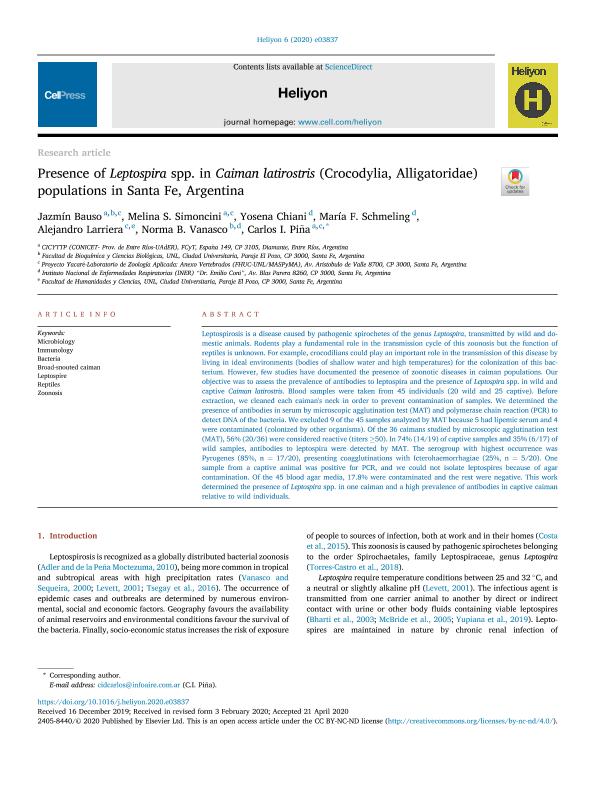Artículo
Presence of Leptospira spp. in Caiman latirostris (Crocodylia, Alligatoridae) populations in Santa Fe, Argentina
Bauso, Jazmín ; Simoncini, Melina Soledad
; Simoncini, Melina Soledad ; Chiani, Yosena; Schmeling, María F.; Larriera, Alejandro; Vanasco, Norma Bibiana; Piña, Carlos Ignacio
; Chiani, Yosena; Schmeling, María F.; Larriera, Alejandro; Vanasco, Norma Bibiana; Piña, Carlos Ignacio
 ; Simoncini, Melina Soledad
; Simoncini, Melina Soledad ; Chiani, Yosena; Schmeling, María F.; Larriera, Alejandro; Vanasco, Norma Bibiana; Piña, Carlos Ignacio
; Chiani, Yosena; Schmeling, María F.; Larriera, Alejandro; Vanasco, Norma Bibiana; Piña, Carlos Ignacio
Fecha de publicación:
05/2020
Editorial:
Elsevier
Revista:
Heliyon
ISSN:
2405-8440
Idioma:
Inglés
Tipo de recurso:
Artículo publicado
Clasificación temática:
Resumen
Leptospirosis is a disease caused by pathogenic spirochetes of the genus Leptospira, transmitted by wild and domestic animals. Rodents play a fundamental role in the transmission cycle of this zoonosis but the function of reptiles is unknown. For example, crocodilians could play an important role in the transmission of this disease by living in ideal environments (bodies of shallow water and high temperatures) for the colonization of this bacterium. However, few studies have documented the presence of zoonotic diseases in caiman populations. Our objective was to assess the prevalence of antibodies to leptospira and the presence of Leptospira spp. in wild and captive Caiman latirostris. Blood samples were taken from 45 individuals (20 wild and 25 captive). Before extraction, we cleaned each caiman's neck in order to prevent contamination of samples. We determined the presence of antibodies in serum by microscopic agglutination test (MAT) and polymerase chain reaction (PCR) to detect DNA of the bacteria. We excluded 9 of the 45 samples analyzed by MAT because 5 had lipemic serum and 4 were contaminated (colonized by other organisms). Of the 36 caimans studied by microscopic agglutination test (MAT), 56% (20/36) were considered reactive (titers ≥50). In 74% (14/19) of captive samples and 35% (6/17) of wild samples, antibodies to leptospira were detected by MAT. The serogroup with highest occurrence was Pyrogenes (85%, n = 17/20), presenting coagglutinations with Icterohaemorrhagiae (25%, n = 5/20). One sample from a captive animal was positive for PCR, and we could not isolate leptospires because of agar contamination. Of the 45 blood agar media, 17.8% were contaminated and the rest were negative. This work determined the presence of Leptospira spp. in one caiman and a high prevalence of antibodies in captive caiman relative to wild individuals.
Palabras clave:
BACTERIA
,
BROAD-SNOUTED CAIMAN
,
IMMUNOLOGY
,
LEPTOSPIRE
,
MICROBIOLOGY
,
REPTILES
,
ZOONOSIS
Archivos asociados
Licencia
Identificadores
Colecciones
Articulos(CICYTTP)
Articulos de CENTRO DE INV.CIENT.Y TRANSFERENCIA TEC A LA PROD
Articulos de CENTRO DE INV.CIENT.Y TRANSFERENCIA TEC A LA PROD
Citación
Bauso, Jazmín; Simoncini, Melina Soledad; Chiani, Yosena; Schmeling, María F.; Larriera, Alejandro; et al.; Presence of Leptospira spp. in Caiman latirostris (Crocodylia, Alligatoridae) populations in Santa Fe, Argentina; Elsevier; Heliyon; 6; 5; 5-2020; 1-5; e03837
Compartir
Altmétricas



